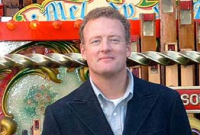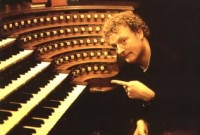HG's Organobilia
1. Something that pumps a lot of air with the help of electricity and makes a huge racket is a vacuum cleaner. An organ is the same thing with shiny pipe attachments, not generally available at department stores. Maybe invented by the ancient Greeks but definitely used by the Romans (parts of one were dug up at Pompeii). Ctesibius of Alexandria invented a mechanical flute-playing device blown by compressed air with then help of water pressure called the hydraulis.
2. No-one can agree about the biggest in the world, but I reckon it’s the so-called Wanamaker pipe organ in a department store in Philadelphia, USA, which has the largest number of pipes (29,000). It spreads over four floors of the shop and is played every day at 12 noon for the customers. The largest organ in the world that doesn’t work would have to be the Richards-Midmer-Losh-Willis organ that used to live in the Convention Hall, Atlantic City, New Jersey, which has 14 swell-boxes, two consoles with 12 manuals and nearly 2000 stops between them, and 33,112 pipes: it was often played by the legendary, appropriately-named E Power Biggs. The Moller chapel organ at West Point Military Academy, already huge, is still growing, since the ranks of pipes are donated to the Academy by the relatives of cadets killed in action for the US military
3. The biggest organ in Europe is probably the monster at Passau cathedral in Germany, though it’s really 5 organs linked together. At the MafraImperial Palace near Lisbon they have 6 organs in one chapel. In 1795 Seville Cathedral had 15 organs.
4. The largest organ inBritainis in the Anglican Cathedral in Liverpool, it has 9704 pipes.
5. In St Joseph’s Church, Las Pinas, in the Philippines, there is an organ made entirely out of bamboo pipes. It was built in 1820 and has survived flood, earthquake, fire, vandalism, civil war, and termite attack.
6. In the town of Noveldain Spain, a chap is building an organ made out of stone (mostly marble and granite), with 700 pipes.
7. There are two organs in southern Scotland which are powered not by electricity but by water from the mains. Apparently they do work but they are rather drippy.
8. In 17th century London it was popular to put organs into public parks and gardens to amuse people as they took their Sunday stroll, at one point there were apparently 65 of them in use. Nowadays there are open air organs in such places as baseball stadiums in the USA, an Alipne valley in Austria, and a desert park in San Diego, California.
9. ‘The Devil’s Organ’ is a weird and wondrous geological formation overlooking ‘The Giant’s Causeway’ in Northern Ireland, by the sea edge, which gives the impression of a row of enormous stone organ pipes carved into the cliff side.
10. A mini-organ that you pump with your feet and actually has tiny little reeds in it is called a Harmonium or Reed Organ. They were very popular in Victorian times for churches that didn’t have very much money or space to build a proper organ. They were exported to all over the oldBritish Empire, it was even possible to buy harmoniums whose wood was injected with special poisons and insecticides to keep off the tropical creepy-crawlies.
11. Although ‘Barrel Organs’ are mainly known for their use with old-fashioned street traders, they were in fact also used in churches. They had cylinders on the inside, which you turned round with a handle on the outside, and spokes and holes on the barrel operated small pipes and reeds as the barrel turned. Thomas Dallam built a barrel organ in 1597 as a gift from Elizabeth I to the Sultan Mohammed III ofTurkey. There is still a working church barrel organ in St Mary’s Church, Wissington, inSuffolk.
12. Yamaha teaches over 10,000 people a year to play the electric organ. There are 180 organ societies in theUK. One of them, the Association of Organ Enthusiasts, is run by the magician Paul Daniel’s brother, Trevor.
13. Electricity was not introduced into organs, to pump the bellows, until late in the nineteenth century. One of the first to have electrical power was the Willis organ at Canterbury Cathedral in 1886. Before that, people had to pump them by hand, or on the very big ones, on a foot treadmill. One of these foot operated treadmills, for 6 people, still exists at thechurchofSt SulpiceinParis. If there was a power cut, they could still theoretically use it, if they could find some volunteers!
14. It is generally agreed by scientists and engineers, that before the Industrial Revolution, the organ was mankind’s most sophisticated machine invention, along with the clock.
15. InLiverpoolMuseum’s Rushworth Collection they have an organ whose pipes are made from bottles filled with wax. It came from an organ constructed in 1798 on theislandofHeligoland.
16. Spanish organs of the 18th century include a number of mischievous sound effects: bird tweeting (pajaritos), military drums (tambour) and horizontal battle trumpets (trompeta real, trompeta magna).
17. The odlest working organ in the world might be in Evora Cathedral Portugal (mostly 1562), or Embrun inFrance (parts from 1463, 1632 and 1750), Sion inSwitzerland (parts from 1380, mostly 1718), or Tuy Cathedral inSpain (bits from 1410, mostly 18th century).
18. The world’s biggest live organ concert took place on April 14th 1996, when, to mark the 100th anniversary of the American Guild of Organists, a simultaneous performance of Bach’s Toccata & Fugue in D minor took place in every town, city and state in the USA.
19. The great French organ builder, Aristide Cavaillé-Coll, at the age of just 22 produced his plans for the design of the organ at the Abbey of St Denis in northernParisin 3 days. He had previously won a design competition with plans for a circular saw.
20. In the Temppeliaukio Church, Helsinki, Finland, which is quarried out of underground rock, there is a 3001-pipe subterranean organ.
21. The ‘Wagner’ organ in Trondheim cathedral, Norway, was made by a colleague of J S Bach inBerlin, but became unplayable during the 19th century and was eventually packed into crates under the cathedral floor to protect it from bombardment in the Second World War. The occupying Nazis in Trondheim discovered this hidden historical gem and had it packed up for shipment back to Berlin. The ship never left harbour, the organ never made it to Berlin (where it surely would have been demolished in the bombing of Berlin) and was triumphantly restored to perfect working order in 1995.
22. In Kuftsein in the Austrian Tyrol there is an organ built inside a tower which plays outwards to the valley. The organist sits in a shed at the bottom of the hill and plays a recital atnoon every day of the year. It was constructed to commemorate the fallen of World War I.
23. In Balboa Park,San Diego,USA, there is a large and impressive outdoor organ in the desert.
24. The famous melody at the beginning of Procul Harum’s song A Whiter Shade of Pale, and which bears a striking resemblance to Bach’s Air on a G String is played on a Hammond B3 electronic organ.
25. At the Villa d’Este, Tivoli, just outside Rome, once home to the flamboyant Cardinal Ippolito d’Este, there was in the 16th century an enormous ornamental fountain with a hydraulic organ built into it. The locals got so fed up with the racket from it at all times of day and night that they vandalised it. It is right now being restored to its former glory by the Italian Ministry of Culture, using the original construction plans, and will soon sing again no matter what the neighbours say!

